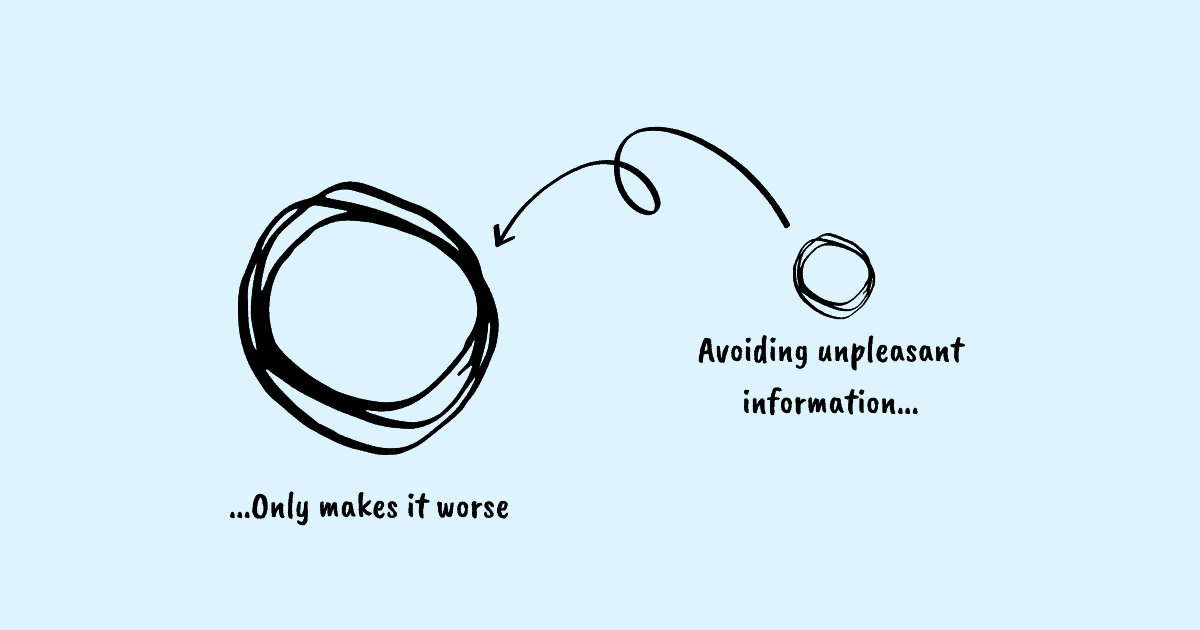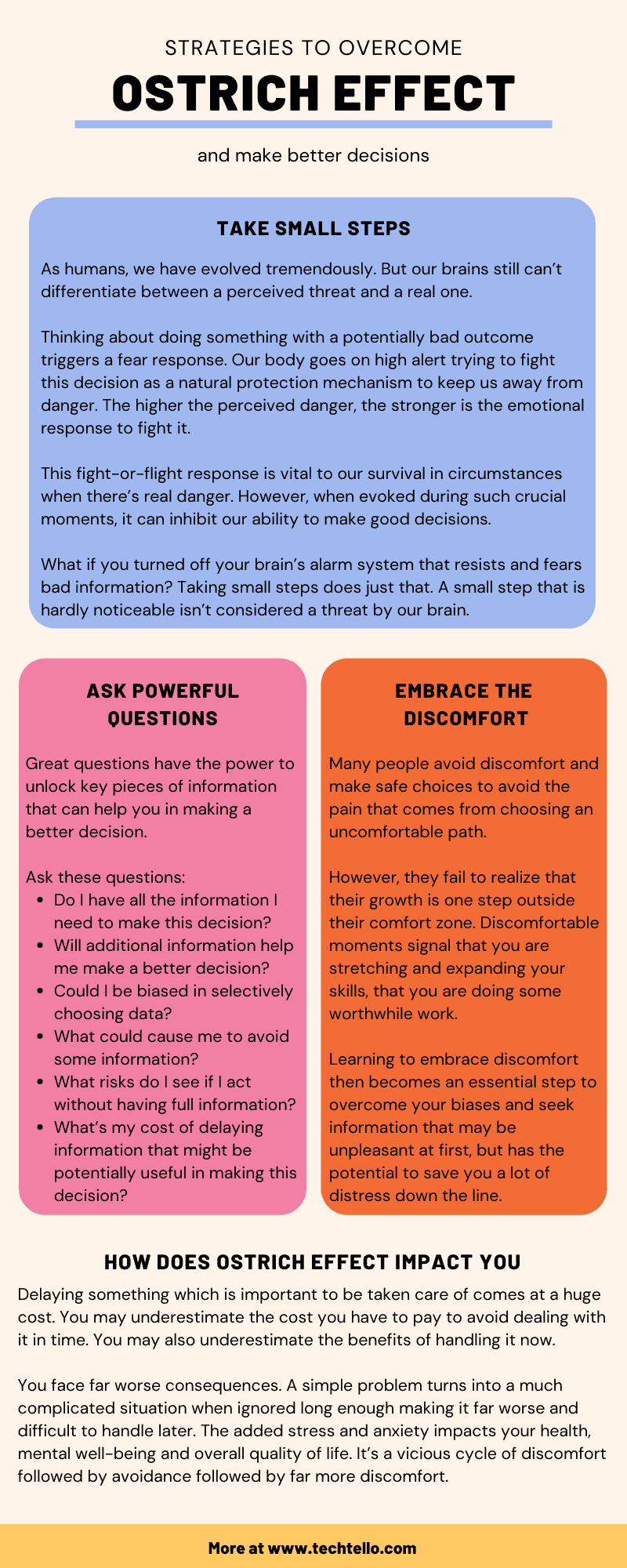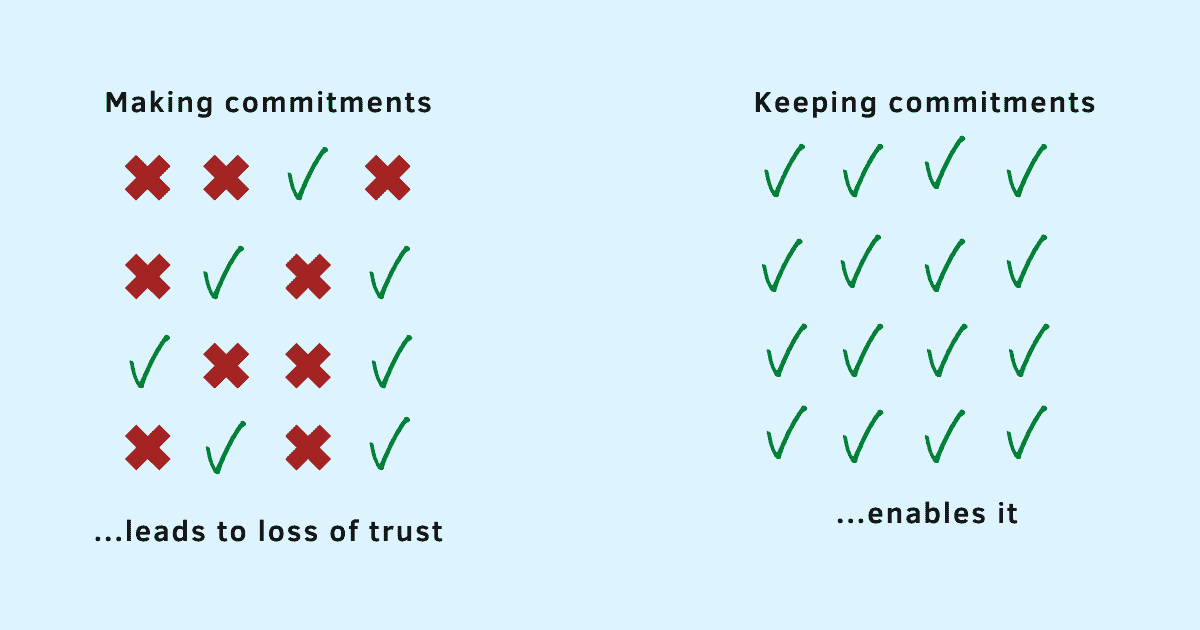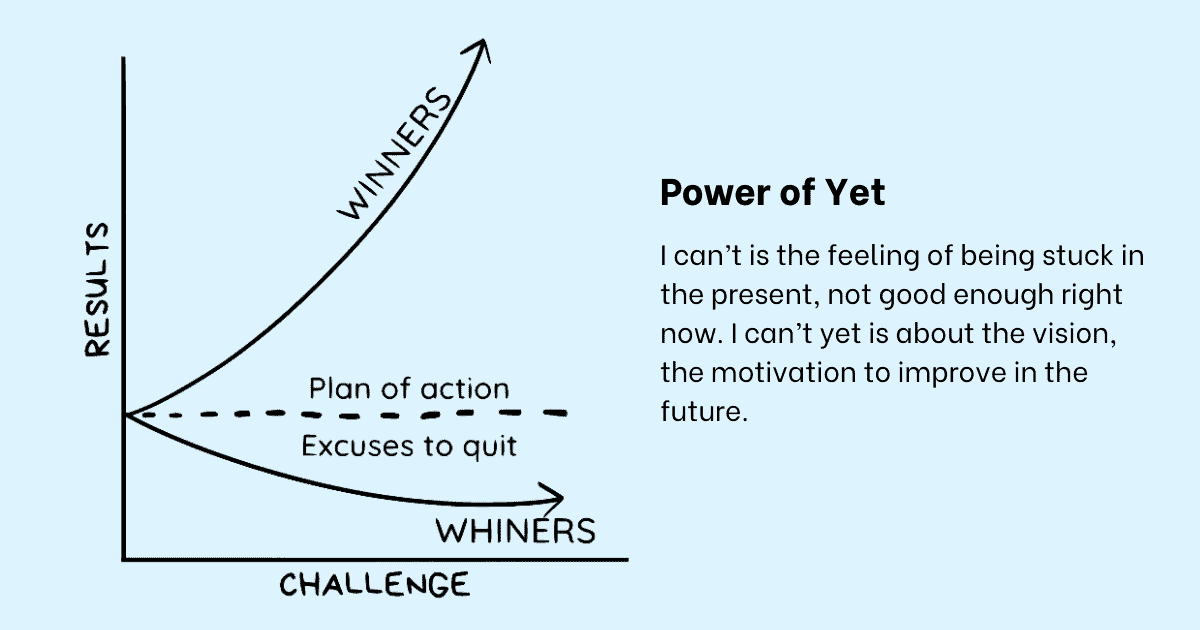Ostrich Effect: Are You Avoiding Unpleasant Information?

Ostriches bury their heads in the sand when they sense danger assuming that the danger will pass if they just avoid it long enough. We humans are no different. When dealing with unpleasant information, or information that challenges us in a way that we don’t want to be challenged, we pretend the information doesn’t exist. We bury our heads in the sand just like the ostriches.
Don’t we all avoid conflict at work just because we fear the conversation or worry about the outcome? Ignoring your boss when you know they might have something negative to say about you. Delaying scheduling a call with a client who’s mad at you for extending delivery timelines. Ignoring data that shows your pet project at work is a disaster while looking for information that justifies your decision. Refusing to measure your work progress when you know that you are falling behind and feel anxious about missing the upcoming deadline.
Some people go as far as avoiding the negative information to protect their self-esteem. They don’t want unpleasant information to destroy the image they have created for themselves.
Unpleasant information creates a paradox for the brain. It’s a conflict between our rational mind that knows something to be important while our emotional mind tries to avoid it anticipating that doing it will be painful. The conflict between what we rationally know is important and emotionally painful makes us look away from information that might be useful.
Behavioural economist George Loewenstein of Carnegie Mellon University coined the term “the ostrich effect” to describe this phenomenon. It is a cognitive bias that makes people avoid negative information, including any feedback that can help them get a sense of how they are doing on their goals especially when the information is perceived to be unpleasant, undesired or evokes strong negative emotional response.
Irrespective of how you choose to respond to undesirable information – completely avoid it, ignore it by not giving it the attention it demands, draw a biased interpretation by rejecting certain views or try to push it from your memory in an attempt to forget about it – they all stem from your need to avoid the uncomfortable.
Daniel Kahneman psychologist and economist notable for his work on the psychology of judgement and decision-making, as well as behavioural economics, for which he was awarded the 2002 Nobel Memorial Prize in Economic Sciences writes in Thinking, Fast and Slow “Many of the options we face in life are mixed: there is a risk of loss and an opportunity for gain, and we must decide whether to accept the gamble or reject it…For most people, the fear of losing $100 is more intense than the hope of gaining $150.”
His research led to this conclusion: losses loom larger than gains and that people are loss averse.
It’s this loss aversion that makes us prone to ostrich effect and avoid any unpleasant information.
Cognitive Distortions Bundle
Challenge and replace irrational thoughts with more realistic and adaptive thoughts.
How does ostrich effect impact you?
Delaying something which is important to be taken care of comes at a huge cost. You may underestimate the cost you have to pay to avoid dealing with it in time. You may also underestimate the benefits of handling it now.
You face far worse consequences. A simple problem turns into a much complicated situation when ignored long enough making it far worse and difficult to handle later. The added stress and anxiety impacts your health, mental well-being and overall quality of life.
It’s a vicious cycle of discomfort followed by avoidance followed by far more discomfort.
Without watching your behavior and thinking in crucial circumstances, the ostrich effect may impact your thinking and make you react unfavorably to undesirable information.
We all fall prey to cognitive biases that get in the way of effective decision making. The only way to change is to want to change.
Avoiding uncomfortable information doesn’t make you stupid, it just validates that you are human. And as a human, you have the capacity to change. This means you can take steps to embrace the discomfort especially when the stakes are high.
Shane Parrish writes in The Great Mental Models “In life and business, the person with the fewest blind spots wins. Removing blind spots means we see, interact with, and move closer to understanding reality. We think better. And thinking better is about finding simple processes that help us work through problems from multiple dimensions and perspectives, allowing us to better choose solutions that fit what matters to us. The skill for finding the right solutions for the right problems is one form of wisdom.”
Mind Map Templates
Work through complex problems, identify correlations, and see the big picture using these mind map worksheets.
Strategies to overcome ostrich effect and make better decisions
1. Take small steps
As humans, we have evolved tremendously. But our brains still can’t differentiate between a perceived threat and a real one.
Thinking about doing something with a potentially bad outcome triggers a fear response. Our body goes on high alert trying to fight this decision as a natural protection mechanism to keep us away from danger. The higher the perceived danger, the stronger is the emotional response to fight it.
Shaped by evolution to protect ourselves from the threats in our environment, the response is almost automatic and unconscious. We feel the pressure building up inside our body – rapid breathing, increased heart beat, sweaty palms, sensation of tightening in the neck and jaw. Our safety is not at risk here, though it certainly feels that way. It’s the result of our fight-or-flight response triggered by the amygdala in our brain or as Daniel Goleman says in Emotional Intelligence, the perceived threat leads to “amygdala hijack.”
This fight-or-flight response is vital to our survival in other circumstances when there’s real danger – to escape a burning building or when a speeding car on a highway heads into our lane. However, when evoked during such crucial moments, it can inhibit our ability to make good decisions.
What if you turned off your brain’s alarm system that resists and fears bad information? Taking small steps does just that. A small step that is hardly noticeable isn’t considered a threat by our brain.
When seeking potentially unpleasant information, try taking small steps towards it. For example, if you need to get a design proposal reviewed but fear that others may not like it, do this:
1st small step: Send a draft proposal to the review team offline asking for their feedback.
2nd small step: Review their comments and incorporate their feedback.
3rd small step: Schedule 1-1 meetings with a few key members if you need clarifications or have specific questions.
4th small step: Send the updated draft to the entire review team again.
5th small step: Schedule a meeting to go over the final proposal. By incorporating early feedback, you will be less worried about receiving negative feedback and can focus on making final corrections to get your design accepted.
By taking small steps towards your goals at work, you can overcome the ostrich effect and make meaningful progress.
2. Ask powerful questions
Great questions have the power to unlock key pieces of information that can help you in making a better decision.
Warren Berger writes in A More Beautiful Question, “If you fear not having answers to the questions you might ask yourself, remember that one of the hallmarks of innovative problem solvers is that they are willing to raise questions without having any idea of what the answer might be. Part of being able to tackle complex and difficult questions is accepting that there is nothing wrong with not knowing. People who are good at questioning are comfortable with uncertainty.”
We make thousands of decisions in a day, big and small. Realistically speaking, it isn’t feasible to optimize all of those decisions. But it will add a lot of value if we can learn to optimize at least a few critical ones.
By asking these questions you can shift your thinking from avoiding information to being actively open to seeking it:
- Do I have all the information I need to make this decision?
- Is there additional information I need to gather that will help me make a better decision?
- Is there a possibility I might be avoiding some data with the fear that it might contradict with my beliefs and expectations? How can I make sure I am not biased in selectively choosing data that matches my belief and rejecting anything that contradicts with it?
- What could cause me to avoid some information?
- What risks do I see if I act without having full information?
- What’s my cost of delaying information that might be potentially useful in making this decision?
3. Embrace the discomfort
Many people avoid discomfort and make safe choices to avoid the pain that comes from choosing an uncomfortable path.
However, they fail to realize that their growth is one step outside their comfort zone. Discomfortable moments signal that you are stretching and expanding your skills, that you are doing some worthwhile work. If you aren’t struggling, you aren’t really learning and growing.
Learning to embrace discomfort then becomes an essential step to overcome your biases and seek information that may be unpleasant at first, but has the potential to save you a lot of distress down the line.
Some great strategies to open yourself to this idea:
- Set goals that require you to step outside your comfort zone and monitor regular progress on these goals. Set automatic reminders or schedule such activities on your calendar.
- Have people close to you hold you accountable for doing the thing that you tend to avoid.
- Write down the problems you faced by avoiding information and refer to them from time to time to serve as a useful reminder of the importance of handling such situations on time.
By building the muscle where uncomfortable moments give you joy instead of causing you pain, you can rid yourself of behaviors that limit your growth as well as the growth of the people around you.
Avoiding information or actively seeking it isn’t always a straightforward decision. When in doubt, remember this final tip: Avoiding information when the extra information only leads to analysis paralysis and doesn’t really help you in making the right decision is a completely reasonable strategy. However, avoiding it only because it makes you uncomfortable is bound to lead to some terrible decisions later.
Summary
- Ostriches bury their heads in the sand when they sense danger. This cognitive bias termed ostrich effect impacts humans as well.
- We tend to avoid information that’s unpleasant, undesirable or evokes a strong negative emotional response.
- Avoiding information, delaying decisions or putting off uncomfortable situations leads to far worse consequences later.
- To overcome this bias, a great strategy is to take small steps which turn off your brain’s alarm system that resists and fears unpleasant information.
- Another strategy is to ask questions that can open your mind to seeking information which can help you in making a better decision even if it’s uncomfortable at first.
- Finally, building the muscle to embrace discomfort will go a long way in making progress on your goals and shaping your future in line with those goals. Once you are comfortable with the negative, you won’t actively avoid it.






























